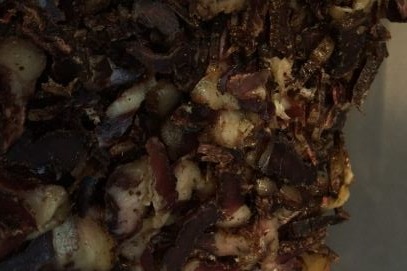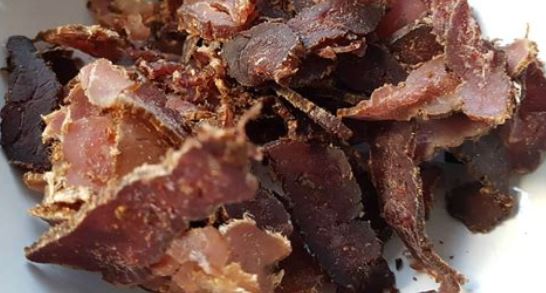From exasperated Reader Lowkey:
Kim,
With much respect… DAMN YOU AND ALL SEFFRICANS for biltong. This stuff is just too tasty and easy to make.
I half-assed a batch (slice roasts into 1 inch-ish strips, soak in cider vinegar for a few hours, dredge in salt/pepper/coriander, then hang for a few days with an old computer fan running to circulate the air) and it’s fecking delicious. I’m gaining weight on what is supposedly a “survival food”.
Damn you.
Please, share with us your recipes for this (and your preferences for it… I seem to like my biltong a touch “wet”).
Actually, Lowkey’s “half-assed” approach isn’t at all bad. Biltong bought online or at specialist food shops can cost up to $20/lb, or even more. 
Make it yourself and it’s the per-pound cost of the meat from the supermarket (usually around $5 to $7). It’s the gastronomic equivalent of handloaded vs. commercial ammo.
It’s been a while (years, actually) since I made biltong, but here’s the scoop on its preparation.
What you’ll need:
- 1lb of boneless beef, whole (not sliced). I like my biltong quite fatty because of the flavor and moistness of the fat layered over the dried beef; your preferences may vary. Just FYI: filet, while tender, doesn’t make decent biltong because of the lack of fat. Top sirloin or bottom round make the best biltong, I think. Feel free to experiment to find your favorite.

- 8 tbsp red wine vinegar (brown apple cider vinegar can be used too).
- 1.5-2 tbsp coarse (kosher) salt (some people like their meat salty, others less so. I prefer less, so I use at most two tablespoons).
- 2 tsp coarse ground black pepper (ditto as for salt; too peppery makes it something other than biltong, but be my guest if you’re of that persuasion. If you must have it spicy-hot — South Africans refer to it as “peri-peri” biltong — then add ground red pepper flakes, but in moderation. I don’t recommend it).
- 2-3 tbsp whole coriander seeds (this is what sets biltong apart; I use 3).
Some people suggest adding brown sugar to the spice mix: these are Satan’s minions, and should be roundly shunned if not actually flogged for their heresy. Jerky is a sweet meat snack for children, and we shall speak no further of it; biltong is a savory snack, and the food of the gods.
Spice mix prep:
- Lightly toast the coriander seeds, then grind into a coarse powder (about the consistency of the black pepper); if you have a few shell fragments left, that’s fine.
- Combine all the dry spices until the mix has a uniform color and consistency.
- Divide the mix in half.
Meat prep:
- Slice the meat with (not against) the grain into broad flat strips about 1.5″ thick. Try to have each piece include a piece of fat along the outside, although if the meat is well marbled, that’s fine too.
- Pour the vinegar into a glass baking dish, then lay the strips down side by side, turning the meat strips over and over to get the vinegar well set into the meat.
- Sprinkle half the spice mix over the strips and rub it in vigorously, then turn the strips over and add the remaining mix, rubbing as before.
- Make sure that the pieces do not touch when you’re done.
- Cover the dish (foil or plastic) and place in the refrigerator for 24 hours. Most of the vinegar and spices should have soaked into the meat by then.
Drying the meat:
- You’ll need an enclosed drying area such as a seldom-used household closet or even a mover’s garment box with some breathing holes punched in the top. Biltong does not need warm air to dry — in fact, many of the biltong cognoscenti will specify cooler temperatures — so an ordinary household climate will do fine.
- What’s important is to circulate the air gently (Reader Lowkey’s use of an old computer fan is spot on), so run a small household fan into the closet/box and set it to its gentlest strength. Do not direct the air flow at the meat or it will dry unevenly.
- Hang the meat strips, making sure that they do not touch each other. Use plastic- or stainless-steel hooks — iron or wire will add a metallic taste to the whole piece of meat over time. I use thick nickel-plated shower hooks, myself.
- Put a tray lined with newspaper (the New York Times is best — it’s about all it’s good for) underneath to catch any drippings.
- Leave to dry for about two to three days, depending on the size of the slices*, then test the biltong by squeezing it gently. It should be outwardly firm, but “give” a little as you press harder. If it still feels “raw” (it won’t), then leave it for another six hours. Feel free to cut a sample piece to check on the hardness.
*Check the meat for mold each day. There shouldn’t be any mold (tiny white spots) on the meat during the drying process, but if there are, wipe them off thoroughly with vinegar and just re-hang the meat.
Some people like their biltong to have the consistency of driftwood — I happen to prefer ostrich or game biltong that way — but the ideal beef biltong should be to have a firm outer crust, with softer meat in the center. The longer you leave it hanging, the harder it will get. Four days is about the maximum for “standard” biltong. The dried strips should look something like this:

Cutting the biltong:
- Biltong is hard meat to cut. Make sure your knife blade is thin and extremely sharp — my grandfather used to use a box-cutter*, and replace the blade for each batch.
- Cut the strips across the grain (unless you want to spend an hour chewing each piece) as thinly as you can, to ~1/16″ to 1/8″ thickness.
- If the biltong pieces are too fatty for your taste, just wrap them all in a paper towel and pat dry.
New Wife and I prefer our biltong “wet” (moist and fatty):

…while others may prefer it a little more dry:

It’s all good.
My suggestion is to cut all the strips into pieces, then store in a greased paper (not plastic) bag in the fridge. It should keep about two to three weeks without any mold growing on it (not that it matters, because I guarantee you’ll eat it all inside a week anyway). When New Wife brought a few pounds of it Over Here for her final Atlantic crossing, we made it last a full month (exercising massive self-control), and the last mouthful was as delicious as the first.
As a survival food, it’s difficult to beat biltong. Three or four small pieces constitute all your protein needs for a day. When I was in the army, I used to buy a single stick of (very hard) game biltong from the commissary just before going off-base (so to speak), and I would consume it over a week. I never went hungry, as long as I had a couple mouthfuls of biltong and a “dog biscuit” (hardtack) each day.
As snack food? Oy. I would remind everyone of Reader Lowkey’s complaint above.
*By “box cutter”, of course, I mean the old-fashioned and robust replaceable-blade kind:

…and not the “snap-off blade” type, use of which will just lead to frustration:

Legal notice: I accept absolutely no responsibility for any ensuing addictions.









